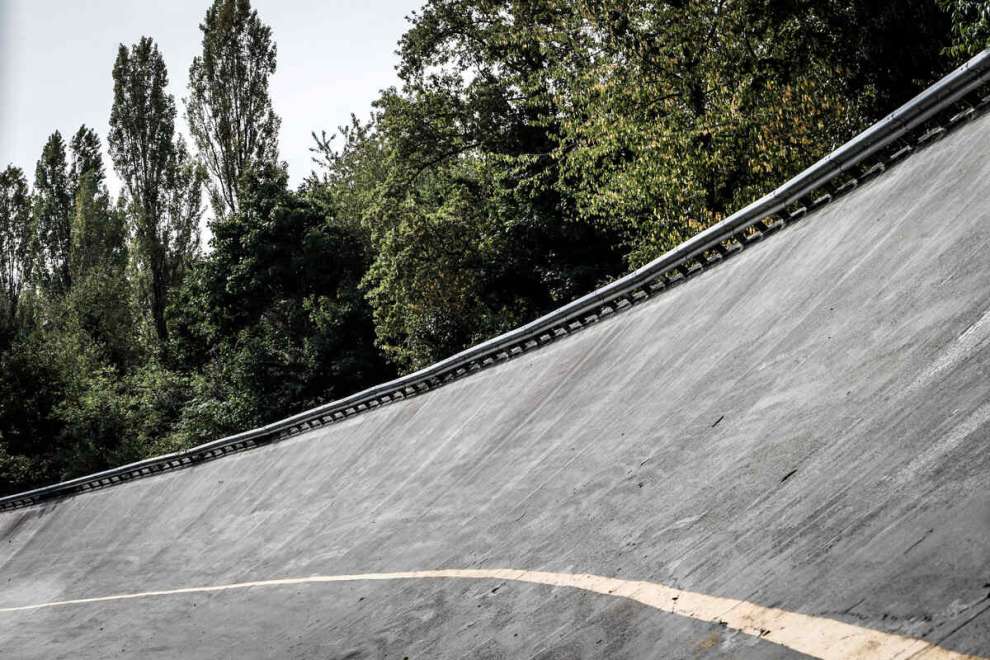Banking between present and past
On curved sections, the transverse slope of the road surface increases the mechanical grip of the tyres: the centrifugal force, compounded with that of the weight, increases the crushing of the vehicle to the ground. Slopes in the order of 3-5%, also improve safety for drainage in the event of rain, for which it is always adopted not only on circuits, but also on the normal road network for which there is a specific regulation. When the slopes increase by at least one order of magnitude then we speak of elevated curves (not parabolic) and the aim is exclusively performance, thus becoming a prerogative of motor racing circuits; or rather, in the first half of the twentieth century, Indianapolis, Brooklands, Monza, Avusring etc. were.
For many years no one spoke about them anymore until they resurfaced Zandvoortduring the renovation a few years ago: curves 3 and 14 were raised to gradients of 34% (19°) and 32% (18°) respectively. The effects were visible and confirmed the designers’ objectives: more overtaking opportunities thanks to both the speed increases on the curves that are reflected in the subsequent sections, in particular 14 on the starting straight, and the possibility of diversifying the trajectories.
With the advent of ground effect cars, DRS was brought forward even in full 14, a real ‘lengthening’ of the main straight. These are the banked curves that liven up today’s raceswhile in Monza no longer, there it is history that revives the memory, for this reason it deserves some in-depth notes.
In the early 1950s the myth of pure speed was still alive and in Monza they wanted to rebuild the high-speed ring, 2 straights and 2 banked curves, taking up the layout present in the first version of the racetrack (1922) but with a much more advanced geometry. They wanted to give the cars the possibility to develop their maximum speeds (also to reach new records), nothing else. In plan they look like 2 perfectly semicircular curves, in reality, as in the curves of the road network, the initial and final sections act as a connection with the straights, they are transition curves (cycloid in most cases, lemniscate in the case of Monza). In other words, they are curves that serve to pass continuously from the infinite radius of the straights to those of the circular arches, thus ensuring a progressive variation of the centripetal acceleration. At the same time, the transverse slope increases, in a mathematically correlated way, as the radius decreases. Even aesthetically these connecting sections are very beautiful because they are harmonious in their proportions, (to me) they remind me of the concept of the golden section.
Here are some summary data of the Monza ring: length 4250 m, 2 straights of 865 m, 2 curves individually composed of 2 connecting sections of 265 m each (start and end), and a central circular section of 745 m with a radius of approximately 320 m and a maximum transverse gradient of 80% (38° 40′). In section, this astonishing value is reached through a polycentric profile starting from a base of 12%. To get an idea of what the effect of the maximum superelevation is, at 180 km/h you could take the curve, on the external trajectory, even with zero-grip tires: in those conditions the driver would not feel any centrifugal force (therefore not even the tires) but only a “crushing” on the seat. In other words, a pendulum placed on the car would remain constantly vertical, a behavior completely similar to that which it would have on an airplane in a turn at constant altitude (on the airplane the pendulum is there and is called a skid meter). In the 50s tires were rapidly evolving, and soon the available friction coefficients (µ at least 0.7) allowed to tackle the elevated roads (at least potentially) at well over 300 km/h. The induced stresses were too high and the high risks that ensued decreed its rapid end. Inaugurated in 1955, F1 abandoned it on emotional wake of the tragic accident in ’61 in which Wolfgang von Trips and 11 spectators lost their livesthe Sports in ’69 (but it had already been distorted with the chicanes) and the Indycars raced there (only the ring) twice in ’57 and ’58.

Today, even by eliminating aerodynamics, these curves could be driven at any speed, I would say only feasible on simulators. For those who go to Monza it is definitely worth a visitis a unique work, testimony to an era in which the myth of pure speed inspired the crowds. When you see it, you will feel that it still continues to do so.
#Zandvoort #Monza #present #united #banking
